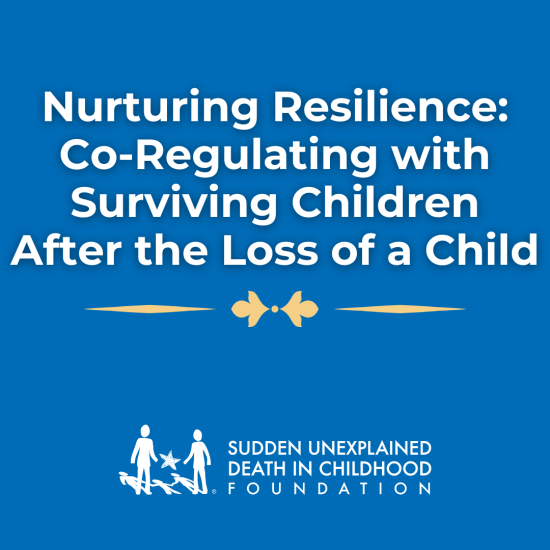21 May Nurturing Resilience: Co-Regulating with Surviving Children After the Loss of a Child

Losing a child is a pain no parent should ever have to endure. The profound grief that follows can feel insurmountable, especially when there are surviving children who also grapple with the loss of their sibling. As parents navigating this journey, we are faced with the immense challenge of not only managing our own grief but also supporting our surviving children through theirs. This task may seem overwhelming, but by understanding the concept of co-regulation and implementing strategies to foster it, we can provide the compassionate support our children need during this difficult time.
What is Co-Regulation?
Co-regulation is the process by which individuals mutually influence each other’s emotions and behaviors in order to achieve a state of emotional balance and regulation. For parents and surviving children after the loss of a sibling, co-regulation involves creating a nurturing environment where emotions can be expressed openly and where both parties feel supported in managing their grief.
Tips for Co-Regulating with Surviving Children:
Validate Emotions: Encourage open communication and validate your child’s emotions. Let them know that all feelings are valid and that it’s okay to express them. Create a safe space where they feel comfortable sharing their thoughts and feelings without fear of judgment.
Model Calm Behavior: Children often mirror the behavior of adults around them. Show them how to stay calm and manage stress by demonstrating these behaviors yourself. Practice deep breathing or mindfulness exercises together to help them learn these techniques.
Maintain Routines: Keeping a regular routine provides a sense of stability and security for children. Consistent meal times, bedtimes, and daily activities can help them feel more grounded and safe during a time of emotional upheaval.
Offer Physical Comfort: Physical touch can be very comforting for children. Simple gestures like hugs, holding hands, or sitting close to them can provide a sense of security and reassurance.
Use Age-Appropriate Language: When discussing difficult topics, use language that is appropriate for your child’s age and developmental level. Be honest but gentle, and make sure they understand that it’s okay to ask questions.
Encourage Expression Through Play: Play can be a powerful way for children to express their emotions and process their experiences. Encourage them to engage in creative activities like drawing, playing with toys, or role-playing scenarios that help them work through their feelings.
Be Patient and Available: Grieving is a process that takes time, and children may need varying amounts of time to express their emotions. Be patient and make yourself available to talk or simply be with them whenever they need support.
Promote Physical Activity: Physical activities can help children manage their emotions and release stress. Encourage them to engage in activities they enjoy, whether it’s playing outside, riding a bike, or participating in sports.
Create Rituals to Remember: Establishing rituals to remember the loved one who has passed away can be healing. This could include lighting a candle, sharing stories, or creating a memory box together.
Seeking Professional Support:
Navigating the complexities of grief and loss, especially within the context of supporting surviving children, can be an overwhelming and challenging journey for parents. Despite our best efforts, there may come a time when we feel unequipped to provide the necessary support or when the emotional weight becomes too burdensome to bear alone. In such moments, it’s important to recognize that seeking professional support is not a sign of weakness but rather a courageous step towards healing.
Professional therapists and counselors specializing in childhood trauma and grief can offer invaluable guidance and support to both parents and children. These professionals are trained to provide evidence-based interventions that address the unique needs of grieving families, helping them navigate the complexities of their emotions and relationships in a safe and supportive environment.
There are many types of therapy and even evidence-based practices for childhood trauma and grief that parents can explore for parent-child counseling:
Trauma-Focused Cognitive Behavioral Therapy (TF-CBT): TF-CBT is a highly effective therapeutic approach for children and adolescents who have experienced trauma. It focuses on helping children process their emotions, develop coping skills, and strengthen their relationship with their caregiver(s).
Child-Parent Psychotherapy (CPP): CPP is a dyadic therapy that focuses on the parent-child relationship as the primary vehicle for healing. Through this approach, parents and children work together with a therapist to process trauma, strengthen attachment, and enhance communication.
Attachment-Based Family Therapy (ABFT): ABFT is a family therapy approach that aims to repair and strengthen attachment bonds between parents and children. It focuses on creating a secure base for the child to explore and process their emotions while providing parental support and guidance.
Navigating the loss of a child is undoubtedly one of the most difficult challenges a parent can face. By embracing the concept of co-regulation and implementing strategies to support surviving children, we can foster resilience and healing within our families. Remember, you don’t have to face this journey alone. Reach out for support from professionals who can provide guidance and assistance along the way. Together, we can navigate this journey of grief and healing with love, compassion, and resilience.



